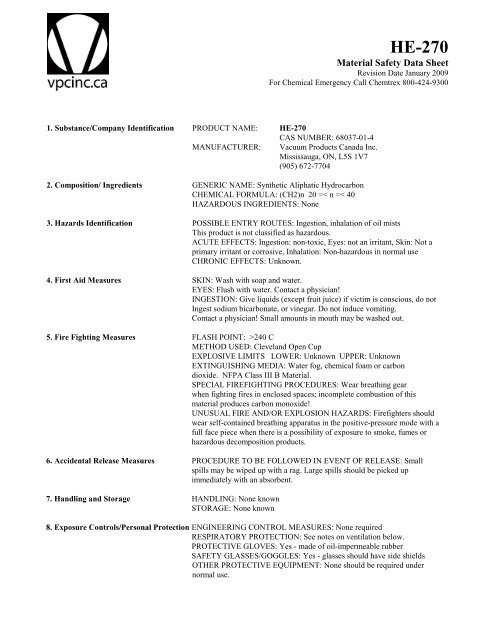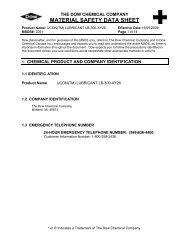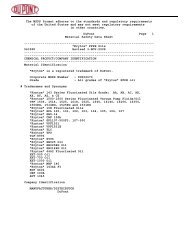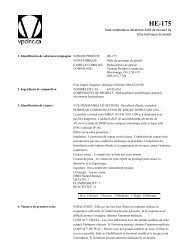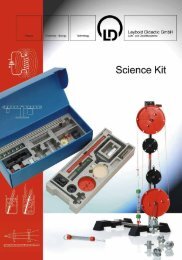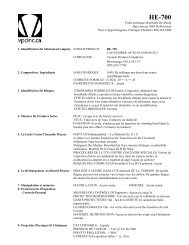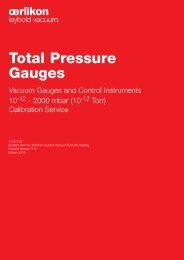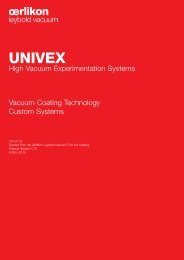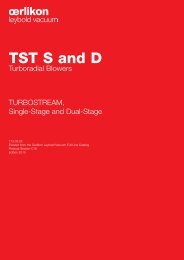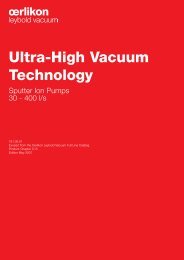HE-270 - Vacuum Products Canada Inc.
HE-270 - Vacuum Products Canada Inc.
HE-270 - Vacuum Products Canada Inc.
You also want an ePaper? Increase the reach of your titles
YUMPU automatically turns print PDFs into web optimized ePapers that Google loves.
<strong>HE</strong>-<strong>270</strong><br />
Material Safety Data Sheet<br />
Revision Date January 2009<br />
For Chemical Emergency Call Chemtrex 800-424-9300<br />
1. Substance/Company Identification PRODUCT NAME: <strong>HE</strong>-<strong>270</strong><br />
CAS NUMBER: 68037-01-4<br />
MANUFACTURER: <strong>Vacuum</strong> <strong>Products</strong> <strong>Canada</strong> <strong>Inc</strong>.<br />
Mississauga, ON, L5S 1V7<br />
(905) 672-7704<br />
2. Composition/ Ingredients GENERIC NAME: Synthetic Aliphatic Hydrocarbon<br />
C<strong>HE</strong>MICAL FORMULA: (CH2)n 20 =< n =< 40<br />
HAZARDOUS INGREDIENTS: None<br />
3. Hazards Identification POSSIBLE ENTRY ROUTES: Ingestion, inhalation of oil mists<br />
This product is not classified as hazardous.<br />
ACUTE EFFECTS: Ingestion: non-toxic, Eyes: not an irritant, Skin: Not a<br />
primary irritant or corrosive, Inhalation: Non-hazardous in normal use<br />
CHRONIC EFFECTS: Unknown.<br />
4. First Aid Measures SKIN: Wash with soap and water.<br />
EYES: Flush with water. Contact a physician!<br />
INGESTION: Give liquids (except fruit juice) if victim is conscious, do not<br />
Ingest sodium bicarbonate, or vinegar. Do not induce vomiting.<br />
Contact a physician! Small amounts in mouth may be washed out.<br />
5. Fire Fighting Measures FLASH POINT: >240 C<br />
METHOD USED: Cleveland Open Cup<br />
EXPLOSIVE LIMITS LOWER: Unknown UPPER: Unknown<br />
EXTINGUISHING MEDIA: Water fog, chemical foam or carbon<br />
dioxide. NFPA Class III B Material.<br />
SPECIAL FIREFIGHTING PROCEDURES: Wear breathing gear<br />
when fighting fires in enclosed spaces; incomplete combustion of this<br />
material produces carbon monoxide!<br />
UNUSUAL FIRE AND/OR EXPLOSION HAZARDS: Firefighters should<br />
wear self-contained breathing apparatus in the positive-pressure mode with a<br />
full face piece when there is a possibility of exposure to smoke, fumes or<br />
hazardous decomposition products.<br />
6. Accidental Release Measures PROCEDURE TO BE FOLLOWED IN EVENT OF RELEASE: Small<br />
spills may be wiped up with a rag. Large spills should be picked up<br />
immediately with an absorbent.<br />
7. Handling and Storage HANDLING: None known<br />
STORAGE: None known<br />
8. Exposure Controls/Personal Protection ENGINEERING CONTROL MEASURES: None required<br />
RESPIRATORY PROTECTION: See notes on ventilation below.<br />
PROTECTIVE GLOVES: Yes - made of oil-impermeable rubber<br />
SAFETY GLASSES/GOGGLES: Yes - glasses should have side shields<br />
OT<strong>HE</strong>R PROTECTIVE EQUIPMENT: None should be required under<br />
normal use.
<strong>HE</strong>-<strong>270</strong> Page 2<br />
9. Physical & Chemical Properties PHYSICAL STATE: Liquid<br />
VAPOR PRESSURE: < .0001 Torr @ 25C<br />
BOILING POINT: >200 C<br />
EVAPORATION RATE (ether = 1): Nil<br />
VAPOR DENSITY: approximately 14<br />
WT % VOLATILES: Nil<br />
SPECIFIC GRAVITY: 0.83<br />
VISCOSITY: 26 cst @ 40 C<br />
SOLUBILITY IN WATER: Nil<br />
APPEARANCE: Colorless liquid with no odor<br />
10. Stability & Reactivity STABILITY: Material is stable<br />
CONDITIONS TO AVOID: Continuous exposure to temperatures > 200 C<br />
INCOMPATIBILITY (MATERIALS TO AVOID): Strong oxidizers<br />
HAZARDOUS DECOMPOSITION PRODUCTS: <strong>Inc</strong>omplete combustion<br />
may produce carbon monoxide.<br />
HAZARDOUS POLYMERIZATION: None likely<br />
11. Toxicological Information ACUTE ORAL LD50(mg/kg): greater than 5.0g/kg(rats) The material is not<br />
classified as toxic by oral administration as defined in 16 CFR 1500.<br />
ACUTE DERMAL: The primary irritation index was found to be<br />
0.5(scale0-8) based on erythema and edema.No evidence of tissue damage<br />
was found. The material is not classified as a primary irritant or as a<br />
corrosive by dermal application as defined by 16 CFR 1500.<br />
ACUTE INHALATION LD50(mg/l: 4.68(rats) for 1 hour. Would be<br />
difficult to work in this heavy mist. May be considered non-hazardous, by<br />
inhalation, for all practical purposes.<br />
12. Ecological Information ENVIRONMENTAL: When used and/or disposed of as indicated, no adverse<br />
environmental effects are foreseen.<br />
MOBILITY: Non-volatile and insoluble in water.<br />
DEGRADABILITY: Slowly biodegradable in aerobic conditions.<br />
13. Disposal Considerations Product and packaging must be disposed of in accordance with Federal,<br />
State and local regulations.<br />
14. Transport Classification USA DOT: not regulated by USA DOT.<br />
RID/ADR : not regulated by RID/ADR<br />
IMO: not regulated by IMO<br />
IATA: not regulated by IATA<br />
15. Regulatory Information US OSHA Hazard Communication Standard: Product assessed in accordance<br />
with OSHA 29 CFR 1910.1200 and determined not to be hazardous.<br />
EU Labeling: not required<br />
Governmental Inventory Status: All components comply with TSCA,<br />
EINECS/ELINCS, AICS, METI, and DSL.<br />
U.S. Superfund Amendments and Reauthorization Act (SARA) Title III: This<br />
product contains no “ Extremely Hazardous Substances”.<br />
SARA (311/312) Reportable Hazard Categories: None<br />
This product contains no chemicals subject to the supplier notification<br />
requirements of SARA (313) toxic release program.<br />
16. Other Information<br />
NFPA RATING<br />
FLAMMABILITY 1<br />
<strong>HE</strong>ALTH HAZARD 0<br />
REACTIVITY 0<br />
SPECIAL HAZARD<br />
NONE


